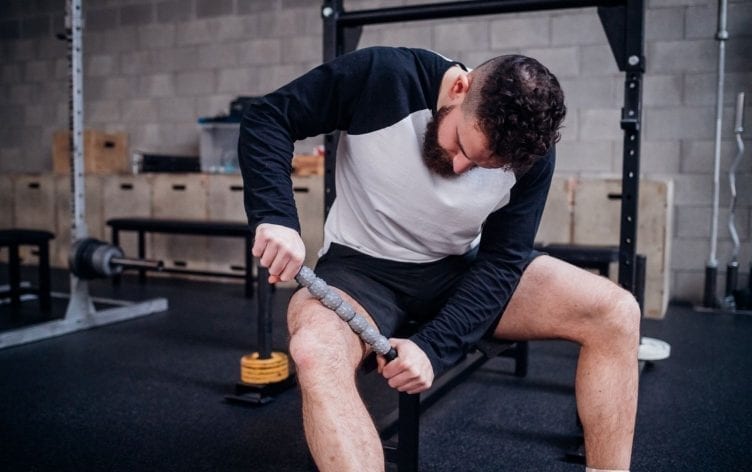
Whether you’re training for a marathon or just sitting at a desk all day, your muscles undergo stress. That can result in fatigue, tightness and even pain. Sometimes, all you need is a good night’s sleep or to do a few stretches. Other times, the problem is deeper and affects your body’s fascia.
According to Johns Hopkins Medicine, fascia is the thin, multi-layer connective tissue that encases your muscles, organs and bones. The tissue is strong, but sensitive, and because it’s laced with nerves, it can tighten up into sticking points, called adhesions, and cause pain.
“Pretty much anything we do in life will cause fascia-related muscle pain and tightness,” says Chris Kidawski, a certified strength and conditioning coach and author of “The Back Pain Bible.” This includes sleeping in an awkward position, lifting weights too frequently, sitting for extended periods, or experiencing a hard fall. “This is why it is so important to work on your body daily to prevent small scale irritations from turning into full-on injuries.”
When fascia issues are not addressed, the tissue, brain and central nervous system continue to tighten and brace the affected area, he says. This may lead to trigger points, which are concentrated areas of muscle tissue that are compressed and squeezing nerves. “You can get pain right where they are developing, or they can be tricky and send pain to another area of the body,” says Kidawski. Because the fascia is tied to muscle, the worse a trigger point gets, the more the fascia guards that area to protect the affected joint. This is why glute pain can present as back pain, quad pain can feel like knee pain, and trigger points in the neck can cause shoulder issues, he explains.
5 MYOFASCIAL RELEASE TOOLS TO TRY AT HOME
Fortunately, there are many ways to address tight fascia and trigger points, many of which can be performed on your own with certain products or techniques. Give these options a try at home, and see if you can bring your fascia back into compliance.
1
PSO-RITE
This handy line of self-massage tools was designed to mimic the hand and elbow of a massage therapist. The Pso-Rite products can address trigger points, tight fascia and stiff muscles, relieve stress and improve circulation to enhance recovery and performance. So, if you’re an athlete — or occasional weekend warrior — this is for you. There are various options for targeting the psoas (a known contributor to hip and lower lumbar pain), back, spine and neck, and there’s even a mini version perfect for travel or for hitting more focused spots.
2
MASSAGE GUNS
Massage guns have become a popular warmup and recovery tool in the past few years, touted for their ability to increase range of motion and reduce stiffness. The percussive nature of the gun increases blood flow to the muscle tissues, which can prepare your body to move. And it can also flush lactic acid buildup out of the muscles, with studies finding vibration therapy can reduce delayed onset muscle soreness.
3
THE STICK
This analog option is, simply, a taut stick surrounded with plastic rollers. But in your hands, The Stick glides up and down your body, letting you apply as much pressure as needed. It’s a great alternative to a foam roller, kneading the muscles in a similar fashion. But it can be difficult to use in hard-to-reach places like your upper back or shoulders, so certain areas may require an assist from a friend or partner.
4
LACROSSE BALLS
Here’s an easy one. Put a lacrosse ball on the floor and lie on it, or put one up against a wall and lean into it. The dense ball can dig into your muscles and fascia to release trigger points, from your feet to your neck. If you need to work around a tendon or your spine, try putting two lacrosse balls into a sock. This creates a peanut shape with a gap in the middle so you can miss those sensitive areas. If the lacrosse ball is too intense, try a tennis ball.
5
GUA SHA
Also called scraping or coining, gua sha is the practice of manipulating the skin with a hard, thin tool to break up scar tissue, smooth out connective tissue, encourage blood flow and promote better movement of the joints and muscles. It can be performed at home or by professional practitioners like chiropractors and physical therapists, and studies show that it may hold promise for pain relief and increased circulation.
WHEN IT’S TIME TO SEE A PRO
Kidawski suggests that people supplement their self-care with professional help if they’re experiencing pain. “Most people don’t maintain their soft tissue health, and they will wait until something gets really bad before they see a doctor.”
If you want to consult a pro, physical therapists, chiropractors and acupuncturists can help. Look for someone who specializes in trigger point therapy or active release techniques. Trigger point therapy is essentially the same as the options above, but the practitioner uses their hands or a tool to apply isolated pressure to relieve tension in constricted areas of the affected muscle and fascia. With active release, the practitioner combines pressure and movement. For example, they will dig into a tight spot to break up adhesions or scar tissue, while you lengthen and contract the muscle.
THE BOTTOM LINE
Of course, you don’t need to be in pain to use any of these techniques — both the self-applied and professional options. Spend a little time on occasional maintenance, and you’ll feel better, perform better and be less likely to require significant treatment down the road.
According to Kidawski, people typically get injured long before the pain develops. “The pain you feel now is your body’s way of telling you it’s had enough.”
Check out “Workout Routines” in the MyFitnessPal app to discover and log workouts or build your own with exercises that fit your goals.



